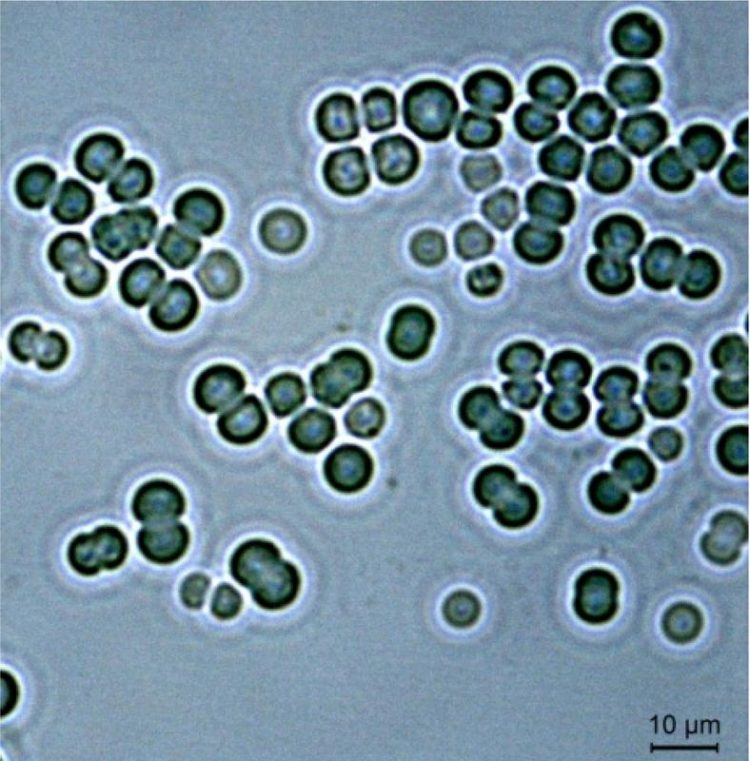Newly-discovered protein operated in earliest organisms

Microscopic image of cells of the cyanobacterium Synechocystis sp. PCC6803 Photo: Khaled Selim
Life on Earth depends on photosynthetic carbon dioxide (CO2) fixation to form organic carbon. Plants take atmospheric CO2 and transform it into organic molecules such as glucose. This process evolved in cyanobacteria and was later conveyed to eukaryotes, giving rise to plastids in algae and plants.
Researchers have now discovered a new protein which is involved in this complex process; it regulates the intake of CO2 into the cell. Khaled Selim and Professor Karl Forchhammer from the Interfaculty Institute for Microbiology and Infection Medicine (IMIT), together with colleagues from the Max-Planck Institute for Proteinevolution and from the University Rostock, describe their finding of the conserved cyclic AMP receptor protein, SbtB, in the latest edition of Proceedings of the National Academy of Sciences (PNAS).
SbtB participates in the sensing of fluctuating ambient CO2 concentrations to adjust CO2 fixation to different environments. SbtB represents a new member of the PII signal transduction superfamily, known for binding the energy carrier molecules ATP and ADP – a kind of battery for the cell.
The newly discovered protein, however, also binds the cyclic nucleotide cAMP, which plays fundamental roles in all organisms for signalling the state of carbon metabolism. Up to now, cAMP was chiefly known for being a key messenger molecule, required in the maintenance of the organisms glucose balance – used for instance in regulating blood-sugar levels.
SbtB is the first protein known to bind cAMP to regulate the CO2 metabolism in cyanobacteria. In identifying SbtB, the researchers have found new principle of carbon sensing through cAMP, which is important for acclimation to varying Ci regimes in the ecological niches of cyanobacteria. Cyanobacteria, also known as blue-green algae, are among the oldest group of organisms on Earth; knowing more about their workings offers clues to very early life on the planet.
Publication:
Khaled A. Selim, Florian Haase, Marcus D. Hartmann, Martin Hagemann, and Karl Forchhammer. PII-like signaling protein SbtB links cAMP sensing with cyanobacterial inorganic carbon response. Proceedings of the National Academy of Sciences (PNAS), USA. https://doi.org/10.1073/pnas.1803790115
Contact:
Professor Dr. Karl Forchhammer
University of Tübingen
Interfaculty Institute of Microbiology and Infection Medicine
Organism Interactions
Phone +49 7071 29-72096
karl.forchhammer[at]uni-tuebingen.de
Media Contact
All latest news from the category: Life Sciences and Chemistry
Articles and reports from the Life Sciences and chemistry area deal with applied and basic research into modern biology, chemistry and human medicine.
Valuable information can be found on a range of life sciences fields including bacteriology, biochemistry, bionics, bioinformatics, biophysics, biotechnology, genetics, geobotany, human biology, marine biology, microbiology, molecular biology, cellular biology, zoology, bioinorganic chemistry, microchemistry and environmental chemistry.
Newest articles

Parallel Paths: Understanding Malaria Resistance in Chimpanzees and Humans
The closest relatives of humans adapt genetically to habitats and infections Survival of the Fittest: Genetic Adaptations Uncovered in Chimpanzees Görlitz, 10.01.2025. Chimpanzees have genetic adaptations that help them survive…

You are What You Eat—Stanford Study Links Fiber to Anti-Cancer Gene Modulation
The Fiber Gap: A Growing Concern in American Diets Fiber is well known to be an important part of a healthy diet, yet less than 10% of Americans eat the minimum recommended…

Trust Your Gut—RNA-Protein Discovery for Better Immunity
HIRI researchers uncover control mechanisms of polysaccharide utilization in Bacteroides thetaiotaomicron. Researchers at the Helmholtz Institute for RNA-based Infection Research (HIRI) and the Julius-Maximilians-Universität (JMU) in Würzburg have identified a…



